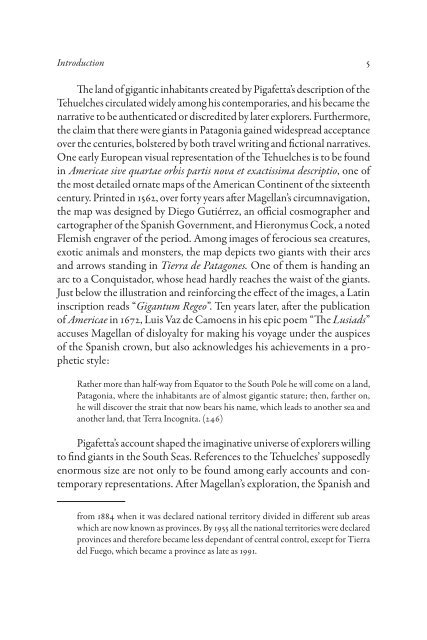Extract (PDF) - Peter Lang
Extract (PDF) - Peter Lang
Extract (PDF) - Peter Lang
Create successful ePaper yourself
Turn your PDF publications into a flip-book with our unique Google optimized e-Paper software.
Introduction 5<br />
The land of gigantic inhabitants created by Pigafetta’s description of the<br />
Tehuelches circulated widely among his contemporaries, and his became the<br />
narrative to be authenticated or discredited by later explorers. Furthermore,<br />
the claim that there were giants in Patagonia gained widespread acceptance<br />
over the centuries, bolstered by both travel writing and fictional narratives.<br />
One early European visual representation of the Tehuelches is to be found<br />
in Americae sive quartae orbis partis nova et exactissima descriptio, one of<br />
the most detailed ornate maps of the American Continent of the sixteenth<br />
century. Printed in 1562, over forty years after Magellan’s circumnavigation,<br />
the map was designed by Diego Gutiérrez, an official cosmographer and<br />
cartographer of the Spanish Government, and Hieronymus Cock, a noted<br />
Flemish engraver of the period. Among images of ferocious sea creatures,<br />
exotic animals and monsters, the map depicts two giants with their arcs<br />
and arrows standing in Tierra de Patagones. One of them is handing an<br />
arc to a Conquistador, whose head hardly reaches the waist of the giants.<br />
Just below the illustration and reinforcing the effect of the images, a Latin<br />
inscription reads “Gigantum Regeo”. Ten years later, after the publication<br />
of Americae in 1672, Luis Vaz de Camoens in his epic poem “The Lusiads”<br />
accuses Magellan of disloyalty for making his voyage under the auspices<br />
of the Spanish crown, but also acknowledges his achievements in a prophetic<br />
style:<br />
Rather more than half-way from Equator to the South Pole he will come on a land,<br />
Patagonia, where the inhabitants are of almost gigantic stature; then, farther on,<br />
he will discover the strait that now bears his name, which leads to another sea and<br />
another land, that Terra Incognita. (246)<br />
Pigafetta’s account shaped the imaginative universe of explorers willing<br />
to find giants in the South Seas. References to the Tehuelches’ supposed ly<br />
enormous size are not only to be found among early accounts and contemporary<br />
representations. After Magellan’s exploration, the Spanish and<br />
from 1884 when it was declared national territory divided in different sub areas<br />
which are now known as provinces. By 1955 all the national territories were declared<br />
provinces and therefore became less dependant of central control, except for Tierra<br />
del Fuego, which became a province as late as 1991.

















